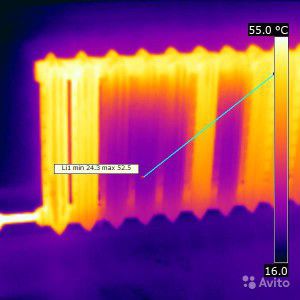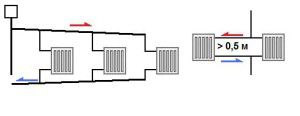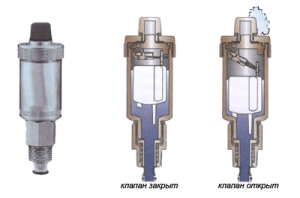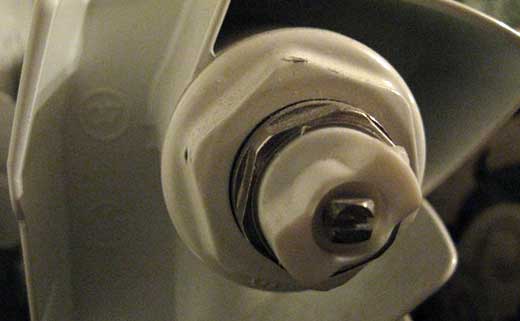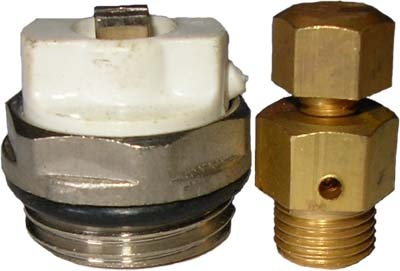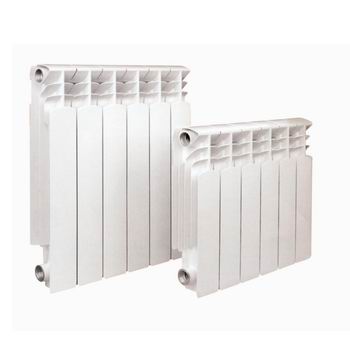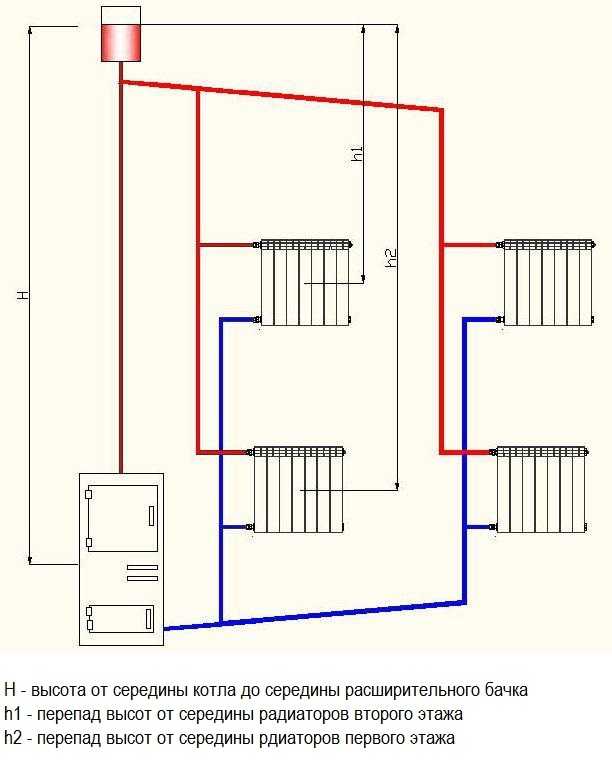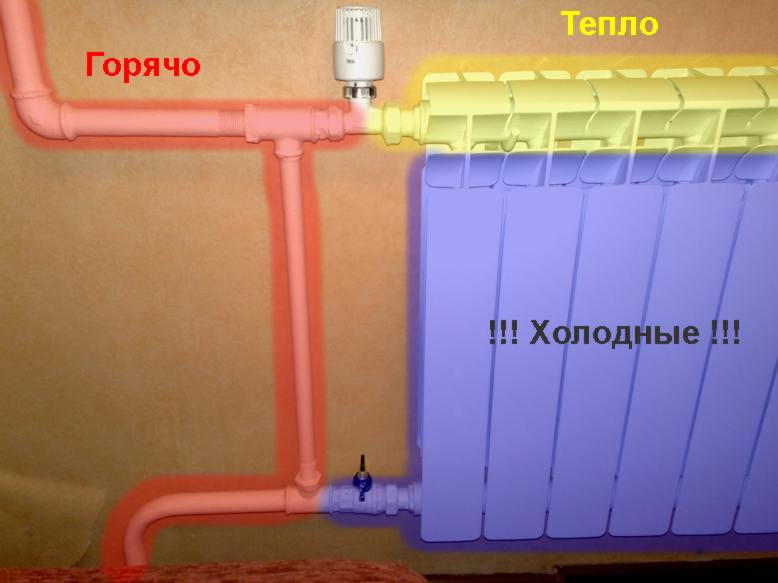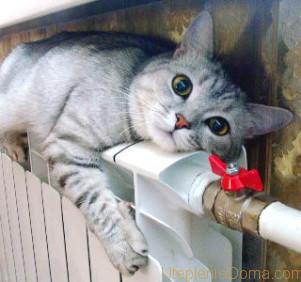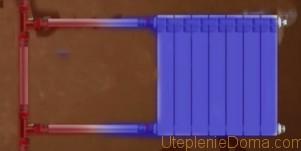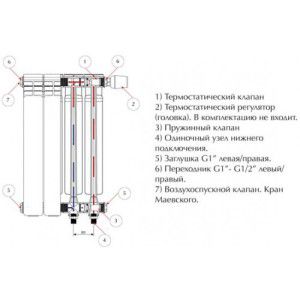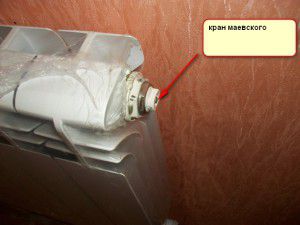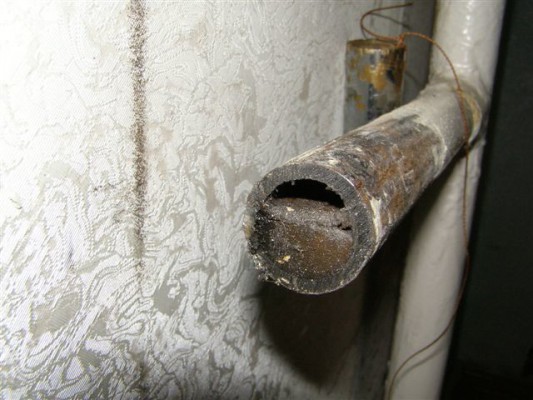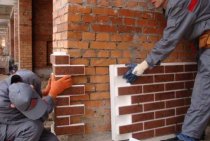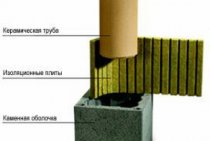Pipelines cause low heat
Failures in the heating mode are characteristic of a two-pipe heating system. In this case, the supply line does not heat, distributing the coolant to the radiators. Identification of the "problem" zone can be done by measuring the temperature on the surface of pipes or a thermal imager.
natural circulation
What could be causing such problems? If the heating does not heat well, it is possible that the slope of the main line is not observed. This only applies to systems with natural circulation. According to the standards, the slope of the pipes should be 10 mm per 1 r.m. In addition, the direction is taken into account - from the accelerating riser to the radiators. For the return pipe, the slope must be towards the boiler.
At the first stage, it is necessary to measure this indicator using the building level. If it corresponds to the norm, but the heating radiator does not heat, there is a possibility of air locks. In this case, an integrated approach is recommended, which includes the following steps:
- Tilt angle measurement. If necessary, change it to the required indicator;
- Flushing pipes to remove limescale;
- Filling the system with coolant with open Mayevsky taps on radiators.
This technique will eliminate the low rate of heat transfer of the heating system.
Forced coolant circulation
For a system with forced movement of water in the pipes, the formation of air pockets can be avoided by using an air vent installed at the top of the system. In part, it performs the functions of an open expansion tank, but it does not reduce the pressure in the pipes to a critical level. Its absence is an indirect cause of poor heating of the heating radiator.
The specificity of closed heating systems lies in the optional observance of the level of pipe installation. However, when the critical level of heating of the coolant is exceeded, steam is released, which is the main cause of air locks. Since air has a lower density than water, it will concentrate in the upper region of the pipeline sections. If heating radiators in a closed system do not heat well, the reason may be a decrease in the volume of coolant in the pipes due to air resistance.
What needs to be done in this case? First of all - check the performance of the air vents. If the valve is left idle for a long time, the valve may become covered with limescale, which makes it impossible to open it with air pressure.
In addition to this factor, it is necessary to take into account the excess of hydraulic resistance in the system. That is why the battery in heating does not heat up if the initial calculation is incorrect. Therefore, before proceeding with the installation of a new system or the modernization of an old one, it is necessary to fulfill the calculated part of the operational and technical parameters:
- Selection of pipes of the appropriate diameter - the larger it is, the less hydrodynamic resistance. However, this increases the volume of water;
- The probability that a two-pipe heating system will not heat is much less than that of a single-pipe one. Therefore, it is preferable to install radiators with parallel connection;
- Heating of the heating circulation pump occurs due to incorrectly selected power. It directly depends on the calculated hydrodynamic parameters.
The video shows the main causes of poor heating radiator for one-pipe heating system:
Air lock what to do
Airlock in a battery is a common problem. Typically, air can accumulate at the top of the radiator.To eliminate this problem, modern heaters use a special tap, which has a two-millimeter hole for air release. It is called "Mayevsky's crane". After turning the tap, a slight hiss will be heard. At the time of water supply, the tap must be closed.
However, prudence must be exercised here. If the water is drained for a long time, then the volume of the coolant can significantly decrease in the system. Therefore, it will be effective to bleed the air again after a certain period of time.
If cast-iron batteries are still used in the apartment, then they do not have a Mayevsky crane. What to do in this case? To do this, you need to use a pipe connection. The work process is complex and unpleasant, since with this option a large volume of coolant will be spilled. When performing this task, care must be taken with the threads. The carving happens both right, and left. When unscrewing the coupling, do not apply much force, as you can break the thread. It is necessary to turn the threaded coupling carefully and smoothly. As soon as a hiss of air is heard, it is enough to unscrew the coupling. As soon as water flows, the coupling must be returned to the reverse position.
But what if there is no heat in the last radiator? Usually from the last battery the pipe goes to the expansion tank. Then, most likely, a blockage formed in this section of the pipe. The situation can be corrected by the laborious and difficult work of cleaning the pipe. But first of all, you need to make sure that this is a problem or not. Therefore, first, the patency of the pipe is checked.
Where to complain about barely warm batteries in the apartment
How to solve the problem with poor central heating? Where to turn, what to hope for, what to demand? tags: barely warm batteries, poor heating category: family and home We had such a situation, and we generally rented an apartment. We called the owner, he told us that we should boldly go there.
They called a specialist (free of charge) and he twisted something there and adjusted it. Now, when we have our own housing and this happens, the husband releases pressure in the batteries by turning the tap on the batteries, maybe there is also such a problem? the author of the question chose this answer as the best comment If the batteries in your apartment are barely warm and do not heat well in winter, then you need to write a statement in two copies and take them to the Housing Office.
Where to complain if the batteries in the apartment are cold
2. To the Moscow United Energy Company (MOEK) to the "hot line" for heating and hot water supply: (495) 539-59-59 (24/7). This multichannel phone can be used to report problems with heating and hot water in the apartment, about an accident, emission and other problems in the heat and water supply system. The hotline operators will also answer questions related to difficulties in paying for heating and hot water.
In the application, briefly and without unnecessary details, state the essence of the issue. If possible, write to whom and when you have previously addressed this problem (name, position, name of organization). Copies of previous appeals, complaints and applications with the answers of officials can be attached to the letter. These documents will help inspectors solve the problem faster.
Doesn't work after repair
The battery may not heat immediately after repair. How to determine what is the problem? Here, what exactly has changed in the apartment will play a big role. For example, pipes can be sewn up with drywall. When mounting the profile, the pipe may touch it. As a consequence, this object will take over the heat that should be directed to the radiator. That is, the heat will spread in the space between the draft wall and the drywall. What to do in such a scenario? To do this, you should check at what level the battery warmed up before repair.If after repair it heats weaker, then the cause should be quickly eliminated.
Air lock in the battery
If the batteries at home do not heat or heat poorly, the most obvious problem is an air lock in the battery. An air lock can interfere with the normal circulation of the coolant in the system, which leads to cooling of the radiators.
Today, with new systems, everything is much simpler, because they are equipped with a special faucet through which air can be bled. Usually the faucet is installed on the battery at the top, either you need to turn it with a screwdriver, or, if you have a special adapter, then just by hand. In this case, a hiss will follow - if there is still air in the system. If there is no air, the coolant, water, will immediately begin to flow out. If the second option, then the problem is not in the airlock and you need to look for another reason.
Do not keep the faucet open for too long. After all, letting in too much coolant, your heating system may suffer a loss of pressure and the boiler will stop altogether. So it is better to repeat the procedure after a while until there is definitely no air in the system. Then the process of work should be normalized and the batteries will heat up.
Worse if you have an old cast iron radiator, because most likely it is not equipped with a drain valve. Well, if you made repairs and changed at least the supply pipes, in this case you can bleed air through a new tap, but if not, then everything is a little more complicated and most likely you will have to get dirty. If there is an air lock in the cast-iron battery, then you need to find a connection in the pipe, on the way to the battery, which is connected by a coupling and turn it. Yes, most likely a dirty coolant will stain your floor or clothes, but the heating system will work clearly more fun
It is IMPORTANT not to apply extra effort, because the thread can be unscrewed in different directions and it is important not to rip it off, because then everything will be much worse and you will definitely have to call a plumber to solve the problem. the fact that you can flood the neighbors from below. So, at your own peril and risk, unscrew the coupling extremely smoothly, or still call a plumber
As soon as you hear a hiss, stop spinning, bleed the air, and as soon as the water has gone, spin it back. It is a fairly common occurrence when you break ancient pipe connections, then water oozes out of them, so before winding back, you can use tow or fumlent. I hope everything goes well and you will enjoy the warm battery. If not, then read on, perhaps the problem is the following.
Incorrect connection is the reason why the batteries do not heat in a private house
There are many design flaws that can cause a system to malfunction. As a result, barely warm or even cold batteries.
Let's analyze the main mistakes and oversights:
The very first reason is the wrong position of the valve on the bypass. What is a bypass? This is a piece of pipe that connects the "supply" and "return" before entering the battery. Its design essence is to shut off the water supply to the battery so that the battery can be easily removed and mounted back. So, if the bypass is open, then the coolant will circulate through it, as if through the shortest path, bypassing the battery and, as a result, non-working batteries.
Illiterate installation of the heating system. Of course, it is possible to highlight in general terms the features of a well-installed heating system, but this is a whole science.
Even the wrong selection of the pipe diameter or the wrong combination of the type of batteries and the heating boiler can lead to permanent malfunctions.
Often the cause of poorly heating batteries can simply be their features.It is very difficult to say which radiators are of high quality and which are not, therefore, read the forum, communicate with trusted consultants and do not let low-quality products “push” you.
https://youtube.com/watch?v=DHdt_67hTWs
Illiterate arrangement of an autonomous heating system
When arranging heating in your home, the question often arises why the last radiators are cold in a two-pipe system.
Why batteries in a private house do not heat well
The batteries in this case can be cold from below, when the “return” and “supply” were confused, or the coolant circulation rate inside the devices is not high enough.
- In the first case, everything is simple. The battery was incorrectly connected to the pipes of the supply and return risers of the heating system. It is enough to disconnect the radiator and connect it correctly, according to the heating scheme.
- When the radiator is hot from above and cold from below in the second case, this is explained as follows. When the coolant flows through the system at high speed, its elements will be hot everywhere. When the speed is low, the water gradually cools down and becomes colder at the bottom of the radiators.
Insufficient coolant circulation
Insufficient coolant velocity occurs in such cases.
- When in any section the inner diameter of the pipe is narrowed.
- When the flow rate of the heat carrier is not high enough in principle.
A common cause of slow water movement is a low-power or faulty circulation pump. In the case of a gravity (gravitational) heating network, it does not exist at all.
The internal cross-section of pipes may unexpectedly decrease in such cases.
- Wrong choice of control valve, with a narrowed inner diameter.
- Poor-quality soldering of plastic pipes, when internal sagging and burrs appear at their junction points.
- Deposits on the walls of the pipes, preventing the passage of a possible volume of coolant and slowing down its flow (hydraulic resistance).
There is another situation when the bottom of the radiator is cold and the top is hot. This is when the room is not insulated (for example, a cold balcony, veranda). If the air temperature in the room is low, then the coolant in the radiator will cool faster.
When the upper branch pipe of the battery is heated and the lower one is cold, then the “return” and “supply” are not confused. Therefore, valves and pipes should be checked.
- If the battery has a control valve, it is worth twisting it and checking it. If you find that its internal diameter is too narrow, you will need to install a valve with a sufficient flow area.
- When the heating pipes themselves have too small an internal diameter or their walls are clogged with deposits, there is nothing left but to change them.
- There is another way out - to install. However, this solution is not entirely correct, and its price is high.
Clogged heating system
Batteries are often cold due to deposits on the inner walls of the case. The reason for their appearance are various impurities in the composition of the coolant and the products of the interaction of hot water and metal. What to do in this case?
Radiators are cleaned in an apartment in several ways, each of which requires certain equipment and performance conditions.
p, blockquote 15,0,0,1,0 —>
If the battery is equipped with taps at the inlet and outlet of the coolant, then it can be washed even when the heating is running. To do this, the radiator is removed and the dirt is washed off with a strong jet of water. In case of failure, the sediment from the walls of the housing is removed using chemicals. After drying, the heater is installed in its place, and the joints are carefully sealed.
p, blockquote 16,0,0,0,0 —>
It is possible to remove deposits from the walls of the batteries without removing them. This is done using special equipment, using the following methods:
p, blockquote 17,0,0,0,0 —>
- Chemical.It is carried out using solutions of organic and mineral acids, alkali and other compounds. It is produced using special equipment, consisting of a pump, a container for cleaning fluid and hoses. The method is indispensable for steel pipes.
- Hydropneumatic. Used with equipment that can generate high pressure. Water is used as a cleaning fluid, due to which turbulent flows are formed that destroy deposits on the walls of pipes and radiators.
- Hydrodynamic. It is carried out with a jet of water under high pressure, the supply of liquid to hard-to-reach places is provided by various nozzles. The cleaning method is effective for cast iron heating elements and is expensive.
- Pneumohydropulse. It is used for batteries and pipes, the diameter of which is not more than 150 mm. Deposits are removed using a water pneumogun, which can act pointwise.
p, blockquote 18,0,0,0,0 —>
As a result of a thorough study of the causes of uneven heating and its competent elimination, cold radiators will become hot, and there will be a comfortable temperature in the living quarters.
p, blockquote 19,0,0,0,0 —> p, blockquote 20,0,0,0,1 —>
In response to your question, the Ministry of Fuel and Energy Complex and Housing and Public Utilities of the Arkhangelsk Region told us the following:
“The rules for the maintenance of common property determine that heating appliances are part of the common property of the house. As you know, the common property of the house belongs to all owners on the basis of the right of common shared ownership and, accordingly, its fate is determined by the decision of the general meeting of the owners of the premises by a qualified majority of votes - at least two-thirds of the votes of the total number of votes of the owners of premises in an apartment building (Article 44, 46 of the Housing Code of the Russian Federation). At the same time, the Rules for the operation of the housing stock clearly establish the obligation of the service organization to control the unauthorized increase or replacement of heating devices inside apartments. The management company or HOA (depending on the chosen method of management) has the right to prohibit the installation (replacement) of heating devices in the apartment if they do not comply with the heating devices provided for by the project. When considering the technical feasibility of reconstructing the heating system in apartment buildings, it is taken into account that the heating systems of the existing buildings were designed in such a way that the heating devices of all apartments in the building are interconnected and any changes in one apartment may affect the heating in other apartments of the residential building. Thus, in accordance with applicable law, when replacing heating appliances, the owner is obliged to contact the managing organization or the chairman (board) of the HOA to resolve the issue of the possibility of replacing the heater, and then bring this issue to the general meeting of homeowners. In case of unauthorized installation of new heating devices, the managing organization or the HOA has the right to apply to the court with a claim for the dismantling of new batteries in connection with their unauthorized installation (violation of the procedure for using common property).
Global heating circuit problems
Kote does not like cold batteries.
The reasons why one battery is hot and the other cold can be global:
- bypass installed incorrectly;
- there is no balancing;
- insufficient pressure.
Bypass installed incorrectly. The bypass is a tube in front of the radiator. It connects the supply of heated coolant and the return. The last battery does not heat well if the bypass is installed too far from it. Indeed, according to the laws of physics, it will be easier for the coolant to pass through the bypass than through the entire heating element.
The bypass cuts directly into the distribution, not through a two- or three-way valve. The coolant enters the radiator through the outlets.As a result, the cross section of the supply pipes decreases. There is not enough pressure in the system to push hot water through the circuit. As a result, the last heating radiator does not heat up.
Error in bypass dimatra.
Incorrect radiator installation. Why is the last battery not heating? Perhaps the last radiator in the heating circuit is too large. It contains more than 12 sections. In this case, the pressure in the system is not enough to drive the coolant through the entire volume of the heating element. The situation is aggravated by the lateral connection. Hot water does not reach the extreme sections. As a result, the last heating radiator does not heat well.
Wrong balance. Balancing the system means uniform distribution of the coolant throughout the entire heating circuit. It is carried out with the help of shut-off and control valves and thermostats. If the last battery in the heating system is cold, then perhaps the problem lies in the uneven distribution of hot water through the wiring.
What should be the thickness of steel pipes for heating? The answer is here.
The radiator does not heat up
Most often, problems with normal heat transfer occur in heating radiators. This is due to their specific design - the coolant does not move through one pipe, as in the transport line, but is distributed over several.
In what cases does the heating radiator not heat up? There are several factors that directly affect the correct operation of the battery.
Air pockets in heating
There are several reasons for the appearance of air jams in the heating system - exceeding the temperature regime, evaporation of water, etc.
It is important that the consequence of this is the appearance of places in the line that are not filled with coolant. Most often these are radiators.
To eliminate them, it is necessary to install a Mayevsky crane - an air valve that releases excess air from the device.
How to determine why the heating radiator does not heat well? The simplest method is the temperature difference on the surface. In the place of formation of an air lock, it will be much lower, thereby preventing the normal passage of the coolant. To fix it, follow these steps:
- With the help of a screwdriver or a rotary lever, the Mayevsky tap is opened;
- Add water to the system until the coolant begins to flow out of the tap together with air;
- Shut off the water supply.
After starting the heating system, the surface of the radiator should heat evenly. Otherwise, repeat the procedure.
Incorrect installation and limescale in pipes
The efficiency of its operation depends on the correct installation of the radiator. It should not be inclined relative to the plane of the floor and wall. If this condition has not been met, then the question will inevitably arise - why the heating battery does not heat up.
To check the correct installation of the radiator, you can take a standard building level. If the upper plane of the battery has deviations, re-installation should be performed. It is best to use new reinforced mounts for this.
If, after this, the question of why the heating radiator does not heat up remains unresolved, it is recommended to flush the heating system. This problem is relevant for old pipes and radiators made of steel and cast iron. Over time, a lime layer accumulates on the inner surface, preventing the normal flow of the coolant. There are several ways to perform the flushing procedure:
- Hydraulic. A special pump is connected to the system circuit, which creates a large pressure of water. Under the influence of this force, the scale is broken into small fractions and retained in the pump filter;
- Chemical. Special additives act on limescale, which loses its uniformity and flakes off the inner surface.Subsequently, hydraulic flushing is performed to remove residual debris.
Experts recommend using an integrated method to solve the problem in which the heating battery does not heat up. After checking the correctness of the installation, the system is flushed, and then the correct filling is performed with an open Mayevsky tap.
If a two-pipe heating system does not heat up due to clogged pipes, you need to carefully choose the cleaning technology. For pipelines made of polypropylene, chemical cleaning cannot be done.
Blockage in the heating system
The reason for the insufficient heat of the battery may be a clog. The blockage is explained by the fact that after a long period of heating operation, the inner diameter of the pipes could be significantly reduced due to the appearance of rust. As a result, it may turn out that there is no room in the pipe for the circulation of the coolant flow. In such cases, it will be necessary to carry out work to clean the battery or replace it completely. To clean or replace the radiator, shut off the coolant supply on the bypass. In this case, the entire system will continue to work. If you can manage only cleaning, then you can use the following tips:
It is important to remember about safety, as the coolant can be very hot.
Cleaning should only be done with high water pressure.
Before re-installing the radiator, check the pipe connections, it is possible that there is also a blockage at the junction that can be cleaned.
It is recommended to clean the radiators all at once.
